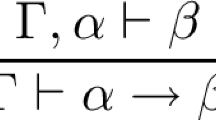Abstract
It is shown that the identity rule — arule of inference which has the form of modus ponens butwith the operation of identity substituted for theoperation of implication — turns any ortholatticeinto either an orthomodular lattice (a model of a quantumtheory) or a distributive lattice (a model of aclassical theory). It is also shown that — asopposed to the implication algebras — one cannotconstruct an identity algebra although the identity rule contains theoperation of identity as the only operation.
Similar content being viewed by others
REFERENCES
Abbott, J. C. (1976). Orthoimplication algebra, Studia Logica, 35, 173-177.
Beran, L. (1985). Orthomodular Lattices. Algebraic Approach, Reidel, Dordrecht.
Pavičić, M. (1987). Minimal quantum logic with merged implications, International Journal of Theoretical Physics, 26, 845-852.
Pavič ić, M. (1993). Nonordered quantum logic and its YES-NO representation, International Journal of Theoretical Physics, 32, 1481-1505.
Pavičić, M., and Megill, N. D. (1998a). Binary orthologic with modus ponens is either orthomodular or distributive, Helvetical Physica Acta, 71, to be published.
Pavičić, M., and Megill, N. D. (1998b). Quantum and classical implication algebras with primitive implications, International Journal of Theoretical Physics, 37, 2091-2098.
Rights and permissions
About this article
Cite this article
Pavicic, M. Identity Rule for Classical and Quantum Theories. International Journal of Theoretical Physics 37, 2099–2103 (1998). https://doi.org/10.1023/A:1026637918703
Issue Date:
DOI: https://doi.org/10.1023/A:1026637918703




